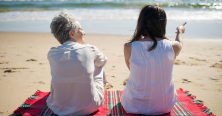
Myasthenia gravis and heat
Last updated Nov. 15, 2024, by Agata Boxe

While heat can worsen your myasthenia gravis (MG) symptoms, adjusting your lifestyle can help lessen its impact.
MG is a rare neuromuscular disease that causes muscle weakness and fatigue. In many people with the disease, heat can trigger the temporary worsening of those symptoms.
Strategies such as staying indoors on warm days or using cooling devices can help you manage the effects of heat on MG.
How heat affects people with MG
Exposure to heat, whether from hot temperatures outside or from getting overheated, can worsen your MG symptoms by affecting the communication between nerve and muscle cells, which is already disrupted in many people with MG.
MG is caused by a mistaken immune system attack against certain proteins in the neuromuscular junction. The junction is where nerve and muscle cells come in close contact, allowing nerves to send signals that tell muscles to contract.
Nerve-muscle communication issues that stem from the attack lead to common MG symptoms such as fatigue, slurred speech, trouble breathing, and difficulty swallowing. You may also experience MG symptoms related to fatigue and muscle weakness in the eye and eyelid muscles, including blurry or double vision, as well as eyelid droopiness, a condition called ptosis.
The effects of heat on MG that can further interfere with nerve-muscle communication is why even small changes in temperature can worsen your symptoms.
Cold, on the other hand, seems to have the opposite effect, leading to a stronger contraction of muscles.
This effect is often seen when doing a simple test that places ice packs on the affected eyelids of people with droopy eyes. If the cold temperature reduces the droop by temporarily making the eyelid muscles tighten up, it may indicate a potential MG diagnosis.
Managing heat sensitivity in MG
Managing MG and heat can help reduce muscle-related symptoms and fatigue in hot weather. Lowering your body temperature — for instance, by taking a shower or having an ice pop — may help counteract the effects of high temperatures on nerve-muscle communication.
Taking breaks during exercise or during chores can help prevent you from getting overheated. It’s also a good way to conserve energy and keep you from becoming exhausted.
In addition to your treatment, you can try to manage MG and heat intolerance by:
- closing blinds or curtains to block the sun
- using air conditioning or fans
- taking a cool to warm shower
- parking your car in the shade
- carrying a lightweight handheld fan
- planning meals that don’t require an oven
- sleeping on cotton sheets.
When the weather is hot, limit being outside as much as you can, especially during the hottest part of the day. Other suggestions include:


Living with MG
Navigating Mental Health with Myasthenia Gravis
- avoiding doing activities outside, such as exercising, gardening, and mowing the lawn
- adjusting the intensity of your workouts and using a cooling towel as needed
- building in extra breaks throughout your day and when exercising
- taking a shower before and after exercise to keep your body temperature down
- ordering groceries online and having them delivered
- Preparing foods the day before when it’s cooler and eating smaller meals throughout the day
- Conserving energy by using a power chair and tools such as an electric can opener and electric toothbrush
- Asking for help with cleaning, laundry, and outdoor chores.
Hydration is key, so make sure to drink enough water and eat foods with a high water content, such as:
- celery
- cucumber
- strawberries
- spinach
- watermelon.
A fast and easy way to eat these foods, especially if you are having problems with swallowing or chewing, is by blending them into smoothies.
Making frozen pops by freezing juices and flavored waters is another thirst-quenching strategy that can also help lower your body temperature.
If you typically wear compression stockings to address leg and ankle swelling from corticosteroids, you may find that hot weather can make them uncomfortable. Switch to ones made of a cooling fabric that wicks away sweat. Some are even infused with menthol to provide an extra cooling sensation.
Finally, if feeling hot while sleeping is an issue, try this unusual but effective solution: An hour before bedtime, place a pillowcase in a plastic bag and put it in the freezer. Take it out of the bag and insert your pillow.
Lifestyle adjustments for warm climates
Living with MG in a warm climate or during the summer season has its own challenges when addressing MG muscle weakness and fatigability, as well as other symptoms.
Modifying your daily routine, selecting the right clothing, and using cooling devices can help lower the potential impact of heat.
Some strategies to consider include:
- limiting time spent outdoors to early morning and evening
- avoiding direct sunlight and wearing sunscreen
- keeping a wide-brimmed hat and an extra pair of sunglasses in your car or bag
- opting for loose clothing made of breathable fabrics
- trying a lightweight neck fan, which blows cool air toward your face and neck
- wearing a cooling vest, also called an ice vest, filled with ice packs
- scheduling regular maintenance of your AC for maximum cooling power
- considering energy-efficient windows and insulated curtains to block heat.
Wearing a medical alert bracelet, engraved with information about your diagnosis, medication, and other relevant details, lets others know what to do in an emergency, including those related to heat.
Heat induced myasthenic crisis is a rare but serious emergency situation caused by respiratory muscles becoming too weak. It’s a severe breathing issue that requires immediate medical care.
If you ever think you’re having a myasthenic crisis, call 911 or go to the ER.
Myasthenia Gravis News is strictly a news and information website about the disease. It does not provide medical advice, diagnosis, or treatment. This content is not intended to be a substitute for professional medical advice, diagnosis or treatment. Always seek the advice of your physician or other qualified health provider with any questions you may have regarding a medical condition. Never disregard professional medical advice or delay in seeking it because of something you have read on this website.
Recent Posts
- Working through myasthenia gravis, one story at a time
- Azathioprine eases MG symptoms, but does not extend survival: Study
- How studying history can help us navigate life with chronic illness
- Povetacicept reduces disease activity in MG mouse model
- The tug-of-war between my independence and his caregiving







